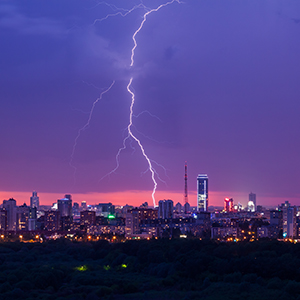Are you Prepared for the Unexpected this Summer?
August 01, 2016

(This article is part of the Roadmap 2 Summer Series. Click here to read last week’s article.)
Summer’s extreme heat and potential for severe weather increase the risk of unexpected equipment failure and power outages. These disruptions can occur for many reasons: high wind, hurricanes or tornadoes; blackouts due to an overly strained utility grid; or even equipment within your building that is past its life expectancy.
An outage can result in business interruption that is costly for you, and your building tenants.
The Northeast power outage in August 2003 — the biggest blackout in North American history — left 50 million people in eight states and parts of Canada in the dark for up to two days. It cost an estimated $6 billion and contributed to at least 11 deaths.[1]
While that was a massive outage of unusual magnitude, a study conducted by the Lawrence Berkeley National Laboratory after the event determined that the national economic toll from power interruptions is $80 billion annually. The majority of these costs — 72 percent — are borne by commercial customers.
The study concluded that power outage costs tend to be driven by the frequency rather than the duration of the event. That means that even momentary power interruptions of just a few minutes can have a very real impact on your bottom line.
Prepare for the unexpected
To minimize your risks and costs, there are several steps you can take to ensure you are prepared for the unexpected.
Step 1: Have a contingency plan. A surprising number of building owners and managers do not have a contingency plan in place to deal with these types of emergencies. Being prepared for power and equipment failure can save you valuable time and money during a crisis. You don’t want to find yourself searching for a generator as a tropical storm makes its way toward your region.
A contingency plan is a detailed document that helps you address equipment failure, power outages and other unexpected situations — so you can minimize expensive business interruption, reduce capital loss and restore normal operations quickly. Your contingency plan should outline a wide range of issues such as where you will hook up equipment and how it will be powered in the event of an outage, and a rental plan with contact information for procurement of replacement equipment in an emergency. If your building is located in a deregulated state, it’s also important to note the contact information for your delivery utility in the event of a power outage, since it’s the utility company — and not your energy supplier — that will restore the power.
Step 2: Get a backup generator. Installing a backup generator is one of the easiest steps you can take to prepare for unexpected power outages. It’s also important to test your backup generator and make sure it is fueled up before the summer season gets underway. A backup generator can keep critical systems inside your building operating, even in the event of a more widespread utility outage. For example, temperatures inside an all-glass high-rise building during a summer power blackout in New York City can top 90 degrees by the second day and can hit 100 degrees by day five, according to data from Urban Green. Avoid this scenario with a backup generator and redundancy built into your building systems, so you can keep your tenants comfortable.
Step 3: Conduct a critical systems audit. An audit of your building systems and equipment will help you identify mission-essential power and HVAC systems and assess their current operating condition. Use the results to address any performance problems and document potential failure points. Many organizations engage a third-party expert like Trane to help with this type of audit.
Be ready for summer’s extremes
Trane can help you develop and implement strategies to meet your heating, cooling and power needs effectively when your permanent building systems go down — regardless of the reason. With proper preparation, temporary solutions can be installed quickly and efficiently so you can keep critical building functions operating with minimal disruption.
Staying cool in the summer heat requires thinking beyond equipment checkups and maintenance. Trane can help you take steps to prepare for the unexpected, so you can keep your building running efficiently all summer long.
Join us next week, when we discuss understanding the cost of energy and the impact that specific actions can have on your utility costs.
Sign up to have the Roadmap 2 Summer Series sent directly to your inbox.
[1] According to an Aug. 13, 2008 article in Scientific American™
